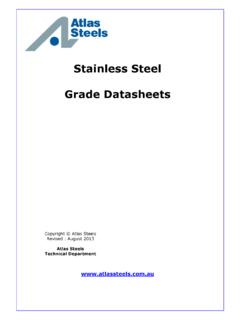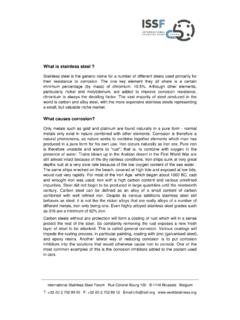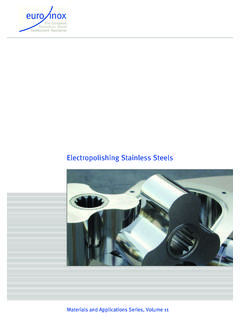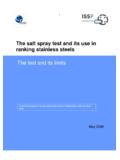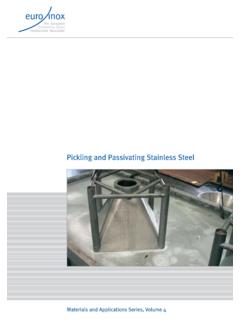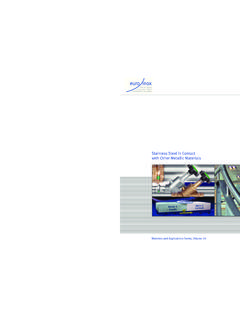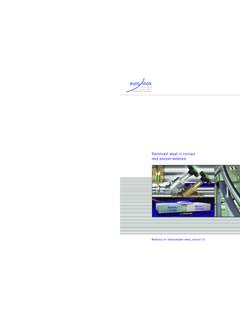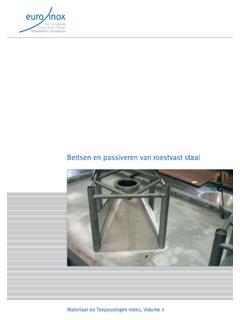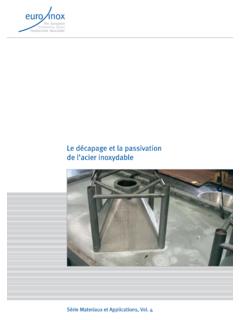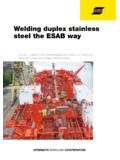Transcription of Stainless Food and Beverage
1 Materials and Applications Series, Volume 7 Stainless Steel in the food and Beverage IndustrySTAINLESS STEEL IN THE food AND Beverage INDUSTRYEuro InoxEuro Inox is the European market development associ-ation for Stainless of Euro Inox include: European Stainless steel producers national Stainless steel development associations development associations of the alloying prime objectives of Euro Inox are to create aware-ness of the unique properties of Stainless steel and tofurther its use in existing applications and in new mar-kets. To achieve these objectives, Euro Inox organisesconferences and seminars, issues guidance in printedand electronic form to enable architects, designers,specifiers, fabricators and end users to become morefamiliar with the material. Euro Inox also supportstechnical and market Acciai Speciali Terni & ALZ BelgiumUGINE & ALZ FranceGroupe Stainless Steel Association (BSSA) Edelstahl de D veloppement de l Inox ( ) Chromium Development Association (ICDA) Molybdenum Association (IMOA) Nickel Institute Polska Unia Dystrybutor w Stali (PUDS) f r nichtrostende St 2-87997-142-x2-87997-189-6 Turkish version2-87997-190-xPolish version2-87997-191-8 Czech versionSTAINLESS STEEL IN THE food AND Beverage INDUSTRY1 Stainless Steel in the food & Beverage IndustryFirst Edition 2006 (Materials and Applications Series, Volume 7) Euro Inox 2006 PublisherEuro InoxRegistered office: 241 route d Arlon1150 Luxembourg, Grand Duchy of LuxembourgTel.
2 : +352 26 10 30 50 / Fax: + 352 26 10 30 51 Executive office: DiamantBuilding, Bd. A. Reyers 801030 Brussels, BelgiumTel.: +32 2 706 82 67/ Fax: +32 2 706 82 69E-mail: , Fairford (UK)Copyright noticeThiswork is subject to copyright. Euro Inox reservesall rights of translation in any language, reprinting, re-use of illustrations, recitations and broadcasting. Nopart of this publication may be reproduced, stored in aretrieval system, or transmitted in any form or by anymeans, electronic, mechanical, photocopying, record-ing or otherwise, without the prior written permissionof the copyright owner, Euro-Inox, may be subject to legal proceedings, mone-tary damages as well as compensation for costsand legal fees involving under Luxembourg copyrightlaw and regulations within the European scope and objectives22 Background23 Why Stainless steel24 Which Stainless steel55 How to fabricate Stainless steel96 Surface finish147 Design principles178 Conclusion209 European standards2110 References2211 Where to go for help2312 Appendix23 AcknowledgementsProduced with kind support from the Nickel Institute,Toronto ( , )Cover Photographs.
3 Centro Inox, Milan (I) Koninklijke Grolsch, Enschede (NL) Packo Inox, Zedelgem (B)DisclaimerEuroInoxhas made every effort to ensure that theinformation presented in this document is technicallycorrect. However, the reader is advised that the mate-rialcontained herein is for general information pur-poses only. Euro Inox, its members, specifically dis-claim any liability or responsibility for loss, damage,or injury, resulting from the use of the informationcontained in this STEEL IN THE food AND Beverage INDUSTRY1 General scope and objectivesExtensive use of stain-less steel for both appli-ances and work-surfacesin the modern : EHEDGThis brochure offers an overview of the ver-satility of Stainless steel as the material ofchoice in the European (and, indeed, glob-al) food and Beverage Industries. Itdescribes the characteristics of the fivemain groups of Stainless steel and indicatesappropriate applications for each.
4 It dis-cusses the techniques for manipulatingstainless steels and the importance of botha smooth surface finish and correct, hygien-ic design. However, it cannot encompassevery aspect of the selection and applica-tion of Stainless steels and so it includeshelpful references to direct the reader tosources of specialist BackgroundThere is a wide range of Stainless steels,each of which offers its own unique portfo-lio of corrosion resistance, mechanicalstrength, formability and weldability. Usingthe most appropriate Stainless steel,preparing it correctly and maintaining itwell can ensure long, trouble-free service atminimum life-cycle Why Stainless steelLong ago Stainless steels established them-selves as the materials of choice for theconstruction of almost all food -processingand storage equipment. But why?
5 Whatattributes make Stainless steels so suit-able?First and foremost must be their corrosionresistance. We are all familiar with howclean and bright Stainless steels remainunder normal atmospheric conditions but itis this general inertness which also makesthem ideal for food contact. After all, ifthere is no measurable chemical reactionbetween the Stainless steel and the food ,notonly will the material remain pristinebut so will the food , untainted by metallicconstituents or corrosion Europe, the Framework Regulation (EC)1935/2004[1] specifically requires that" food contact materials, under normal orSTAINLESS STEEL IN THE food AND Beverage INDUSTRYEnd-use market break-down of Stainless : estimates fromISSF data, 2005 Stainless steel builds upon its surface an invisi-ble, protective oxidefilm, known as 'the pas-sive layer'.
6 If this isdamaged, it re-formsspontaneously under theinfluence of oxygen fromair or conditions of use, do not trans-fer their constituents to foods in quantitieswhich could endanger human health orbring about an unacceptable change in thecomposition of the food or a deteriorationin its organoleptic characteristics". Thisregulation may be further specified innational regulations; [2].Grade (AISI 304) the stainlesssteel with which we are most familiarbecause of its wide-spread use for domesticcutlery and hollowware is used so exten-sively in food and Beverage preparationprecisely because it remains inert in somanyfood environments. And it is tolerantofthe powerful detergents which may berequired tokeep the plantclean. In fact, Stainless steel is rapidly replacing othermetallicmaterials in food processing andcatering corrosion resistance comes from aninvisible, protective film of chromium-richoxide whichstainless steels or more of chromium form sponta-neously in the presence of oxygen or oxy-genated water.
7 Even if it is physically orchemically damaged, this film will very rap-idly repair itself once the source of the dam-age is removed and the surface is exposedto oxygen , in addition to this inertness (whichoffers the added advantage of non-toxicity), Stainless steels have many more propertieswhichmake them ideal choices for food -processing plant and equipment. It is easyto create smooth, non-absorbent surfaceson Stainless steels and the inherent hard-ness of this family of materials helps tokeep those surfaces smooth. The relation-ship between the roughness of a food -con-tact surface and the ease with which foodswilladhere to it (and also the difficulty oftheir removal) is well-documented [3], andso a surface which will remain smooth for along period oftime will resist the accumula-tion of bio-films which can present ahygiene hazard.
8 It will therefore remaineasy to maintain to a high standard steels are tolerant of the widerange of temperatures frequently encoun-tered in the production offoods, from cook-ingtofreezing, and they resist thermalshock a rapid and significant change oftemperature importantly, the physical properties ofstainlesssteels make it easy to construct34 Stainless STEEL IN THE food AND Beverage INDUSTRYS tainless steel surfacesare bright and attractiveand above all easilycleaned and : Cedinoxfrom them plant which can process foodseffectively and economically and to designwith them equipment which can easily becleaned and maintained, often without theneed for dismantling (Cleaning in Place).They are strong. They can be formed intothe necessary shapes for food processing,transportation and storage, and they arereadily welded (see section 5 below).
9 Theyresist impact, fatigue, wear, abrasion anderosion , HACCP (Hazard And CriticalControl Point) analysis requires that theoperators of any commercial process,includingfood processing and packaging,should activelylookfor potentialthreats tohealth, safety and hygiene. A 'threat' isdefined asanything from infection resultingfrom poor design or lackofhygiene,through the degradation of materials byerosion or corrosion, to component failureby fracture or fatigue. HACCP systems mustnow consider the possibility of materialscontaminating the foods with which theyare in contact. In any state of the EU, com-petent national authorities' inspectors candemand to see HACCP analyses to deter-mine if all possible risks really have beenassessed and appropriate action course, as with any material, the selec-tion of the most appropriate grade of stain-less steel and the optimum surface finishfor the intended conditions of use, togetherwith the application of good design, fabri-cation and maintenance practices is essen-tial, and these are discussed later in reliability and longevity of stainlesssteels also contribute significantly to theirfavourable Life-Cycle Costs.
10 But even whenapiece of Stainless steel equipment hasreached the end of its useful life, the stain-lesssteelitself hasn't. Today, a newly-man-ufactured stainlesssteel object will have anaverage recycled content of about 60% a feature particularlyimportant whenpresenting food either in the retail outlet orin the domestic environment is that stain-less steels are pleasing in popularity of Stainless steels in thefood industry is due to a combination ofpracticality and figure. See also CD-ROM The Recycling of Stainless Steel Luxembourg: Euro Inox 2004 Stainless STEEL IN THE food AND Beverage INDUSTRY4 Which Stainless steelThe blade of this knife ismade of martensiticstainless steel : W sthofJust as 'steel' is iron which contains a con-trolled amount of carbon, so ' Stainless steel'is a steel which contains a controlled amountof chromium.
